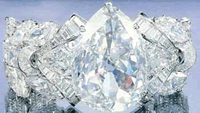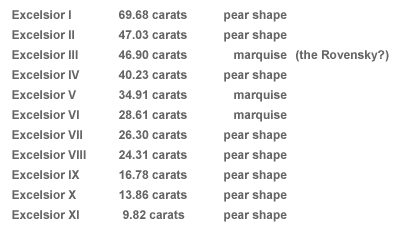On May 28th, 1971, a sad but inevitable event in mining history occurred: operations finally stopped at the Jagersfontein Mine. Not long before, the mine had celebrated its centenary, the first diamond having been picked up in the Jagersfontein valley in the Orange Free State in August of 1870. Although Jagersfontein was the first South Africa ‘pipe’ or ‘dry diggings’ to have been established, its fame was always overshadowed by the mines in the Kimberly district, about 130 km northwest. Yet the output of the diamond mine was great enough to inspire the term “Jagers” to denote a diamond with a beautiful faint bluish tint. In addition Jagersfontein was the source of two of the largest and finest diamonds ever found.
The earlier of these discoveries caused the most dramatic moment in the diamond mine’s history. On the evening of June 30th, 1893, an African picked up an immense diamond in a shovel of gravel which he was loading into a truck; he hid it from his overseer and delivered it directly to the hands of the Mine Manager. As a reward he received £500 plus a horse equipped with a saddle and bridle.
The diamond weighed 971 old carats, equivalent to 995.2 metric carats. It possessed the fore mentioned blue-white color characteristic of the finest Jagersfontein diamonds, especially cleavages, and was of very fine quality, although there were a number of internal black spots, another Jagersfontein characteristic. The shape of the diamond was out of the ordinary: flat on one side and rose to a peak on the other, somewhat like a loaf of rye bread. Apparently this is what inspired the diamond to be named ‘Excelsior’, meaning higher.
The Excelsior may justly lay claim to be the ‘Great Unknown’ of famous diamonds. As will be explained further along, there is no single Excelsior fragment of exceptional size which would have helped to keep its name in the public eye, thus helping keep track of the fragments. In addition, except for having stimulated some interest among local diggers, the finding of such a large diamond seems to have made singularly little impact. No account of the discovery appeared in the more authoritative and prestigious British newspapers which often reported lesser diamond discoveries at the time. Maybe if the diamond had been originally been given a less unglamorous name its fame might have spread further outside of South Africa. Yet consider the facts … before the discovery of the Excelsior the only rival to the diamond was the legendary Great Mogul, of Indian origin, generally thought to have weighed 787.5 old carats in the rough. The so-called Braganza Diamond, which was found in Brazil in the 1700s and according to some sources weighed 1680 carats, was considered to have been a white sapphire, topaz or light aquamarine, very unlikely a diamond. So the Excelsior still ranks as the second largest rough diamond of gem quality ever found, only the Cullinan being larger.
After various highs and lows the Jagersfontein Mine eventually became the sole property of the New Jagersfontein Mining & Exploration Company Limited, formed in April of 1887. It so happened that on the very day the Excelsior was found the contract between the mining company and the consortium of London firms which purchased the diamond mine’s output expired. If the diamond had been found a few hours earlier it would have made a substantial difference in profit to the parties concerned.
The diamond was shipped to London where it was joined in 1895 by the second of the two large diamonds to have originated in the Jagersfontein. This diamond weighed 634 carats, equivalent to 650.8 metric carats, and was first named the “Reitz” after F.W. Reitz, then president of the Orange Free State. It was renamed the ‘Jubilee’ when it was cut in 1897, the year of Queen Victoria’s Diamond Jubilee; the 75th anniversary of her coronation.
Excelsior I Bracelet
In 1897, the Jubilee crystal was cut the following year into two diamonds. The larger of the two was a rectangular cushion shape diamond weighing 245.35 carats, which would rank as the sixth largest polished diamond in the world. But no buyer appeared on the scene for the Excelsior crystal and eventually in 1903, it was sent to I.J. Asscher of Amsterdam. This famous company, destined to cut the Cullinan diamond crystal, had been founded by Mr. J.J. Asscher (1843-1902).
Yet another misfortune dogged the Excelsior, since it was destined not to become one of those diamonds which yields a single magnificent gem, instead it was cut into a number of smaller diamonds. There were suggestions that no prospective buyer could be found due to the diamond’s extraordinary size. In his book, Some Dreams Come True, by Alpheus F. Williams, who succeeded his father as General Manager of De Beers, entertained no doubts about the subject, considering the decision to cleave the diamond into several smaller fragments as the greatest tragedy of modern times in the history of famous diamonds. he wrote:
“It was unpardonable that this exquisite diamond was so cleaved that the largest stone cut from it weighed only 70 metric carats. The intrinsic value meant more to its owners than its historical importance, so different from the spirit of the owners of the Cullinan diamond who, in deciding to have the diamond cleaved into nine pieces, insisted that one of the pieces so cleaved should be, when cut, the largest diamond in the world.”
After prolonged study it was decided to first cleave the diamond into ten pieces: this operation which was performed by Mr. A. Asscher, resulting in the three largest diamonds weighing 158, 147 and 130 carats. The polishing was supervised by Henry Koe and yielded 21 gems, ranging from 70 carats to less than 1 carat. They totaled 373.75 carats which represented a loss in weight of almost 63 percent. The final result, however, was considered to have been better than anyone had expected. The specifications of the larger diamonds cut from the Excelsior are as follows:
The Excelsior diamonds were sold separately; three of them were bought by a famous New York jewelry company., in their old store in Union Square in New York City. The names of the other buyers have not been disclosed but it is known that De Beers displayed one of the marquise-shaped diamond fragments at the 1939 World’s Fair in New York.
In January of 1984 Graff Diamonds Limited of London announced the acquisition and subsequent sale of five exceptional diamonds among a series of transactions to clients. The most historic diamond was the Excelsior I which according to Laurence Graff, had remained in the possession of the same family in the United States until his firm’s purchase of it. The diamond reappeared for sale in May of 1991. The GIA certified it as ‘G’ color and VS2 clarity. In May of 1996 reappeared yet again for sale and was bought by Robert Mouawad for $2,642,000.
It is possible that two more of the larger diamonds cut from the Excelsior rough may have come to light within recent years. At an exhibition called The Court of Jewels presented by Harry Winston Inc. in San Antonio, Texas in 1949, there was a 40-carat marquise diamond measuring 25.4 by 19 mm. There appears to have been little known about this diamond before its purchase from Harry Winston by a prominent American family. Could it have been the Excelsior IV? On January 23rd, 1957, a diamond necklace with a pendant, owned by Mrs. John E. Rovensky came up for auction at Parke-Bernet Galleries. The pendant was a pear-shaped diamond weighing approximately 46.50 carats. Since it had originally been purchased from the famous jeweler in New York, is there not a distinct possibility that this diamond was none other than the Excelsior III?



